Cleaning instrument for a tooth root canal
a cleaning instrument and root canal technology, applied in the field of tooth root canal cleaning instruments, can solve the problems of root canal, root canal, root canal rinseout, etc., and achieve the effects of facilitating the attachment of a head portion, facilitating the torsional rigidity and bending rigidity of the shank, and cleaning especially well
- Summary
- Abstract
- Description
- Claims
- Application Information
AI Technical Summary
Benefits of technology
Problems solved by technology
Method used
Image
Examples
Embodiment Construction
[0028] A cleaning instrument 10 shown in FIG. 1 has a head portion 12 and, adjacent thereto, a cleaning portion 14. The cleaning instrument 10 is used for removing, from a tooth root canal, material that has remained behind in the tooth root canal after the latter has been cleared out using a drilling or scraping instrument. It is furthermore possible, using the cleaning instrument 10, also to clean regions of the tooth root canal that cannot be cleaned using drilling instruments. In FIG. 1, the cleaning instrument 10 is not shown true to scale but rather, for the purpose of better representation, in greatly shortened form.
[0029] The head portion 12 is formed substantially by a sleeve 16, which can be fixed in a drill chuck of a drilling or cleaning device (not shown). In an alternative embodiment (not shown), the head portion 12 has a hand grip, by means of which the cleaning instrument 10 can be introduced into a tooth root canal manually and moved, especially rotated, therein.
[00...
PUM
 Login to View More
Login to View More Abstract
Description
Claims
Application Information
 Login to View More
Login to View More - R&D
- Intellectual Property
- Life Sciences
- Materials
- Tech Scout
- Unparalleled Data Quality
- Higher Quality Content
- 60% Fewer Hallucinations
Browse by: Latest US Patents, China's latest patents, Technical Efficacy Thesaurus, Application Domain, Technology Topic, Popular Technical Reports.
© 2025 PatSnap. All rights reserved.Legal|Privacy policy|Modern Slavery Act Transparency Statement|Sitemap|About US| Contact US: help@patsnap.com


